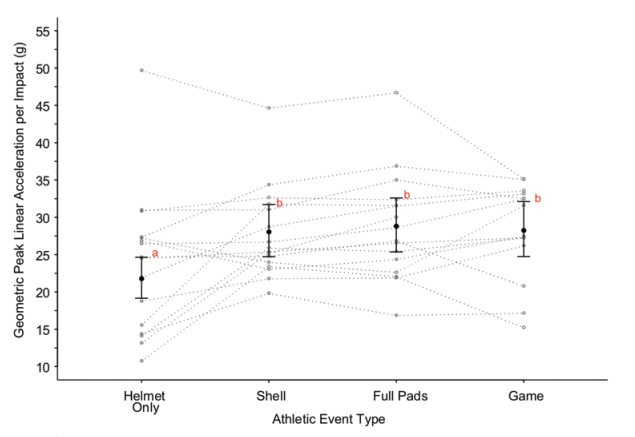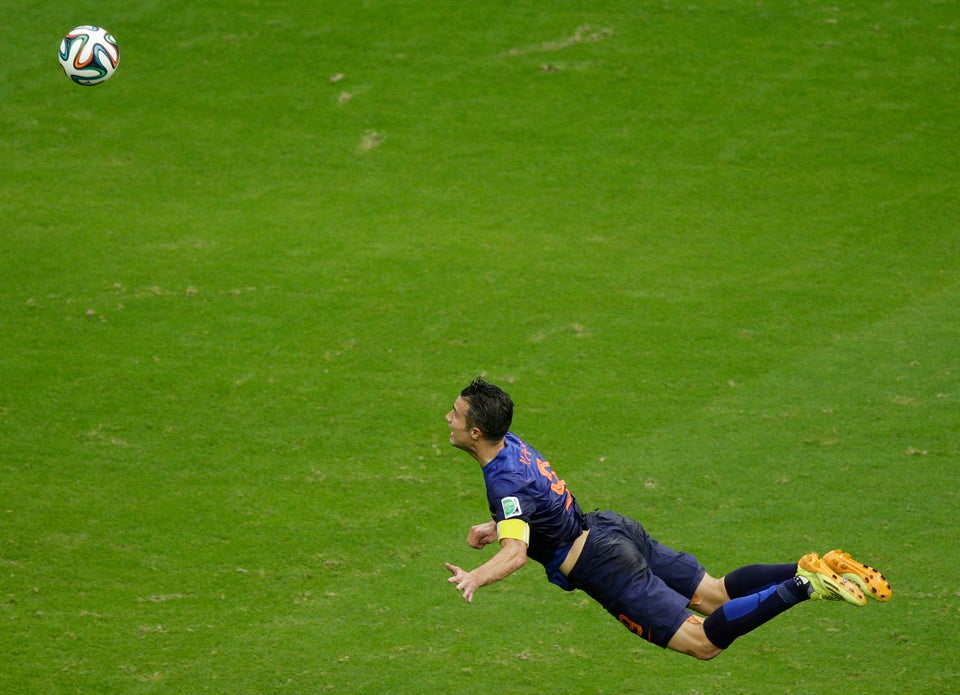
When researchers at the University of Virginia discovered a relationship between the type of equipment worn by their school’s football players at practice and the head impacts sustained as a result, they didn’t think much of it at first.
After attaching sensors behind 20 football players' ears, the researchers had found that players experienced a much smaller average number of head hits during helmet-only practices than they did during shell practices and full-pad practices. When it came to the severity of the hit, the same was true: helmet-only practices looked safer. According to researchers, "the level of protective equipment worn is generally a good proxy measure for the intensity of a practice."
“It seemed like sort of an intuitive finding [at first],” Jason Druzgal, an assistant professor of radiology and one of the paper's authors, told The Huffington Post over the phone. “We didn’t really think much of it.”


But when the researchers looked into what rules currently govern NCAA football practices to figure out how their research might fit in, they discovered something curious: There weren’t any. Instead, the NCAA had crafted what the organization calls guidelines, suggestions for how teams run their practice.
Concerned by this lack of regulation, the researchers decided to end their paper, which was published last week in the Journal of Neurosurgery, with a warning against the NCAA's “take it or leave it” approach to football guidelines:
The present data suggest that similar regulations in college football [to those in the NFL] would reduce the burden of head impact for thousands of athletes. While the research community should continue to investigate the cause and nature of these practice type differences, the potential human cost of leaving practice equipment unregulated seems unnecessarily high.
There’s no question the NCAA is lagging behind the NFL when it comes to instituting firm practice rules on the football field. In 2011, as part of a new collective bargaining agreement with the NFL Players Association, the NFL agreed to limit the amount of full-contact practices during both training camp and the regular season.
The NCAA still doesn’t have any such mandatory rules. In their place are suggested interassocation guidelines, which NCAA chief medical officer Brian Hainline told The Huffington Post puts “cultural pressure on everyone to follow through."
"Is everyone following them? I don’t know with certainty. But I’m pretty sure they are," he said.
That lack of certainty has led to intense criticism of the NCAA from many within the both football community and scientific community in recent years. Druzgal and Bryson Reynolds, a doctoral candidate in neuroscience and the study’s first author, aren’t convinced either. While some schools and conferences might put their student athletes' safety first and foremost, the researchers questioned whether individual powerhouses and ultra-competitive conferences like the SEC and ACC would prioritize adhering to guidelines over winning games.
“An individual team is not going to reduce its aggressive practices if it’s going to reduce its competitive advantage,” Bryson said. “So [any real change] has to be at the NCAA level.”

Hainline toed the NCAA line in his conversation with HuffPost, saying the organization is waiting until it has sufficient data to suggest legislation that football programs across the country will be obligated to follow. But Chris Nowinski, the executive director of the Sports Legacy Institute, a nonprofit that focuses on concussion reasearch, questioned the approach.
“To say the research isn’t there is so the wrong way to look at things,” Nowinski said. “Who is carrying the risk if they are wrong? If some doctors want to sit there and say, 'I don’t have perfect evidence to make a choice,' that’s fine. But it isn’t their [lives]. It’s the kids’ [lives].”
Hainline appears confident in the organization's approach anyway, noting that the NCAA has worked closely with 11 medical organizations to institute its current guidelines, and that the organization will reconvene in February to update the guidelines according to new information.
By then, Hainline said, the NCAA will hopefully have the first round of data from its joint concussion study with the Department of Defense, a $30 million initiative announced last year that the two organizations are touting as the largest study in the history of concussion research. Because of that incoming data, Hainline said he is “confident” the legislation that so many seek could be around the corner.
“In February, we’re going to have some, I’m hopeful, some fairly compelling data that is going to first lead to an update in the guidelines, and I’m hopeful that’s going to be a pathway for legislation,” he said.
Whether Hainline's confidence is justified is up for debate. Imposing legislation is a longer and more tricky process than proposing guidelines, and Hainline is just one member of a large and powerful organization.
Thomas Buckley, an assistant professor in the department of kinesiology and applied physiology at the University of Delaware, is heading up his school's part of the mammoth NCAA-DOD research initiative. He told HuffPost he believes that Hainline is doing the best job he can to "change the culture" within the “slow-moving” NCAA. “I [just] do not think he has succeeded entirely yet," he said.
Nowinski similarly applauded Hainline’s work, but said his hands will always be tied to a certain degree within the NCAA. “Should [football practice] be legislated? Absolutely. Should the players be deciding? Absolutely. But that’s not [Hainline’s] call,” Nowinski said.
Nowinski believes the NCAA’s unwillingness to impose guidelines at football practice is a direct result of college football players having “zero voice" when it comes to rules. If they had a say, he said, they would already be protected.
“We know that athletes are in greater danger if they are hitting a lot in practice, Nowinski said. “When the NFL players themselves saw the data they quickly went out and got restrictions."
Regardless, there appears to be room for optimism that legislative rules will one day keep the NCAA's college football players safe. The only question is why the NCAA is taking so long to take turn its suggestions into demands.
“When you’re talking about the sort of change that’s been instituted at the NFL level -- and done so successfully -- I don’t see a cost to implementing the change [at the NCAA level],” Druzgal said. “I do see a cost to waiting and finding out.”
“It’s a minor change,” Druzgal added. “It’s not like you’re changing the game.”
Also on HuffPost:

